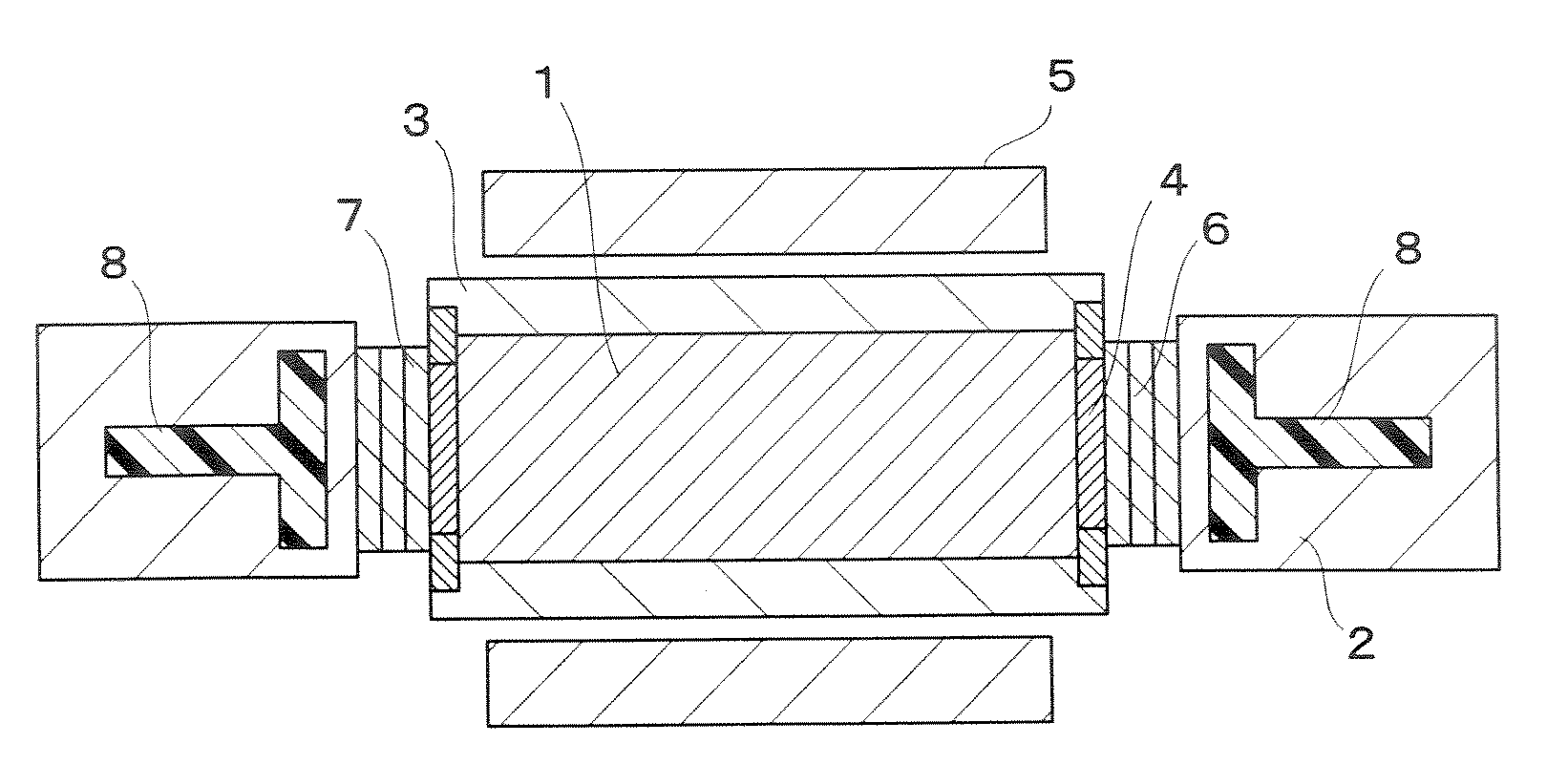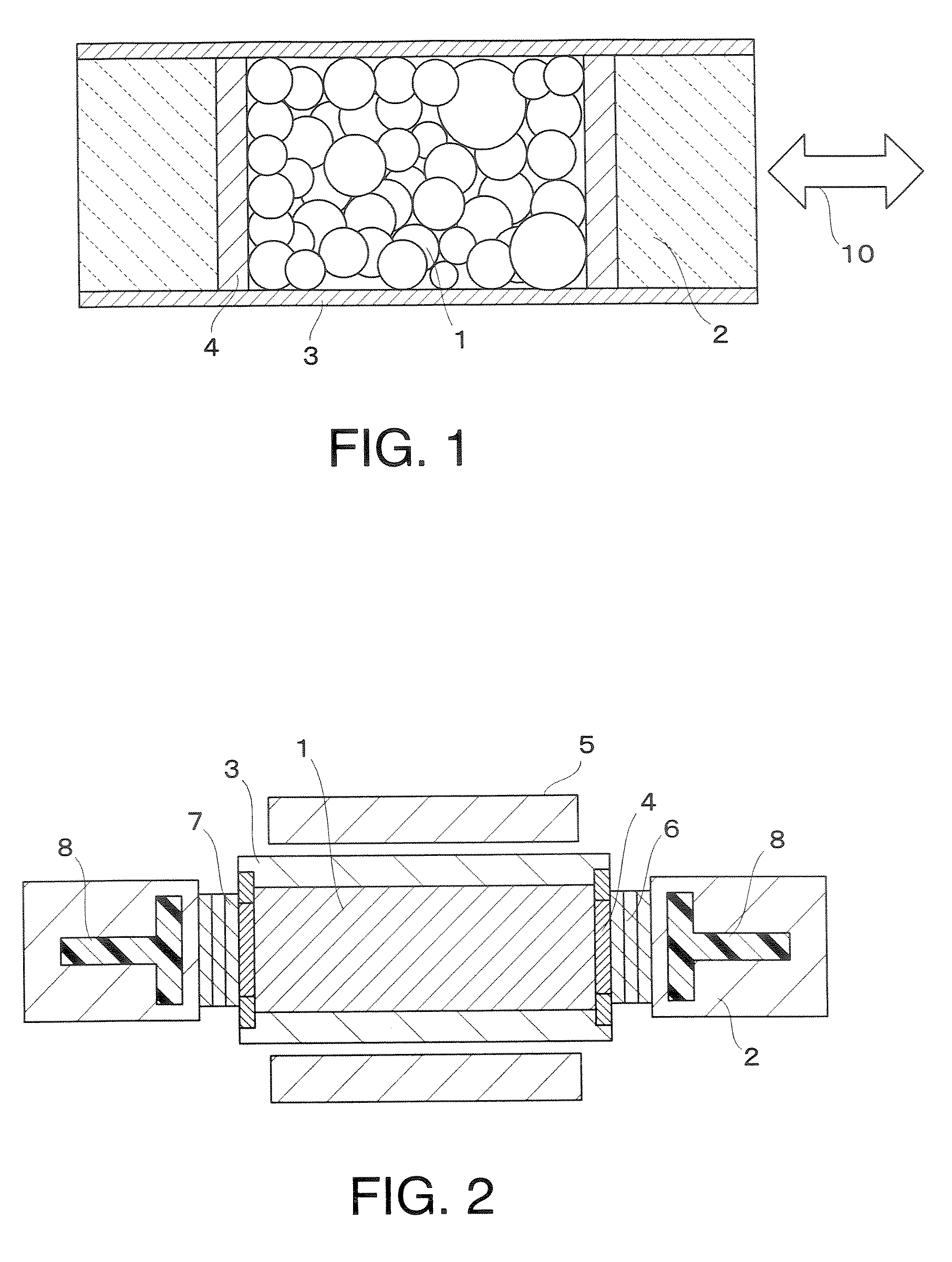Magnetic refrigeration material and magnetic refrigeration device
a magnetic refrigeration and magnetic technology, applied in the direction of magnetic bodies, liquid/solution decomposition chemical coatings, lighting and heating apparatus, etc., can solve the problems of significant heat exchange efficiency degradation and inability to achieve steady state, so as to prevent the heat exchange efficiency from lowering and improve the heat exchange efficiency
- Summary
- Abstract
- Description
- Claims
- Application Information
AI Technical Summary
Benefits of technology
Problems solved by technology
Method used
Image
Examples
example 1
[0034]Gd was used to produce spherical powder having a diameter of 0.1 to 2.0 mm in an inert gas by a rotating electrode process (REP). The Gd spherical powder was subjected to surface analysis to find that it was covered with a thin gadolinium oxide layer. It was an oxidized layer formed by the exposure to the atmosphere after forming the spherical powder. The oxidized layer had low heat conductivity of up to 5 W / m·K, inhibiting the heat exchange efficiency. Then, Gd spheres which were classified into a diameter of about 500 μm were immersed in a 0.001 to 0.01% solution of hydrochloric acid at normal temperature for about 5 minutes to 30 minutes or in an about 1 to 3% solution of sodium hydroxide at 90 degrees C. for about 1 to 10 minutes. Subsequently, the Gd spheres were put in a mesh basket and stirred by rotating to form an aluminum layer on the surface in an inert gas by an ion plating method. The aluminum layer was determined to have an average film thickness of about 0.1 μm ...
example 2
[0036]After the washing process with the acid or alkaline solution of Example 1, Sample 4 (an average film thickness of 5 μm) Au-plated and Sample 5 (an average film thickness of 5 μm) Cr-plated were subsequently produced. The obtained samples were filled in about 100 g into the magnetic refrigeration device based on the AMR heat cycle shown in FIG. 2 and checked for a temperature span at room temperature of 21 degrees C. to obtain the results as shown in Table 1. As shown in Table 1, both Sample 4 and Sample 5 had a good temperature span, and no abnormality was observed when the surfaces were visually observed after the test.
example 3
[0037]After a mother alloy of LaFe13 was produced, spherical powder having a diameter of 0.3 to 1.3 mm was produced in an inert gas by the rotating electrode process (REP). The spherical powder was subjected to a heat treating process and a hydrogenating process to obtain LaFe13H spheres having a Curie temperature of about 19 degrees C. Then, after the washing process with the same acid or alkaline solution as that described in Example 1, Sample 6 (an average film thickness of 5 μm) Au-plated and Sample 7 (an average film thickness of 5 μm) Cr-plated were produced. The obtained samples were filled in about 100 g into the magnetic refrigeration device based on the AMR heat cycle shown in FIG. 2 and checked for a temperature span at room temperature of 19 degrees C. to obtain the results as shown in Table 1. As shown in Table 1, both Sample 6 and Sample 7 had a good temperature span, and no abnormality was observed when the surfaces were visually observed after the test.
PUM
| Property | Measurement | Unit |
|---|---|---|
| thickness | aaaaa | aaaaa |
| magnetic field | aaaaa | aaaaa |
| Tc | aaaaa | aaaaa |
Abstract
Description
Claims
Application Information
 Login to View More
Login to View More - R&D
- Intellectual Property
- Life Sciences
- Materials
- Tech Scout
- Unparalleled Data Quality
- Higher Quality Content
- 60% Fewer Hallucinations
Browse by: Latest US Patents, China's latest patents, Technical Efficacy Thesaurus, Application Domain, Technology Topic, Popular Technical Reports.
© 2025 PatSnap. All rights reserved.Legal|Privacy policy|Modern Slavery Act Transparency Statement|Sitemap|About US| Contact US: help@patsnap.com



